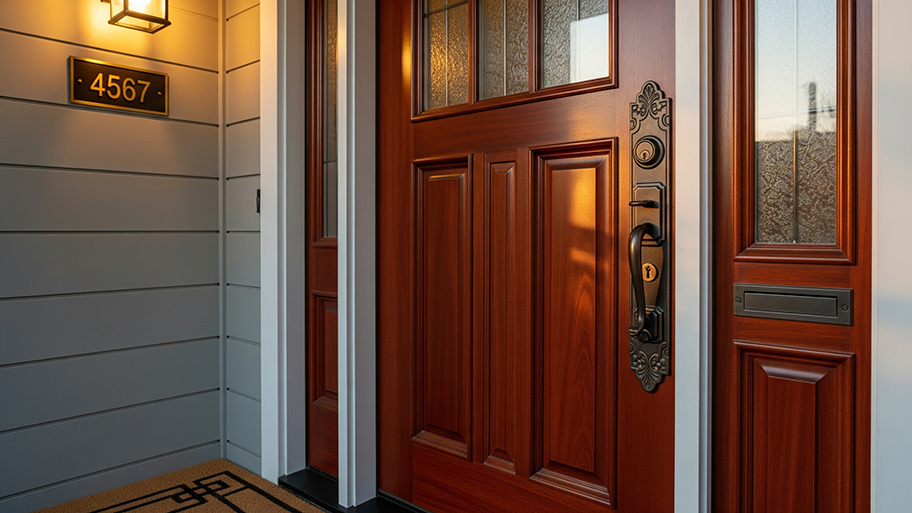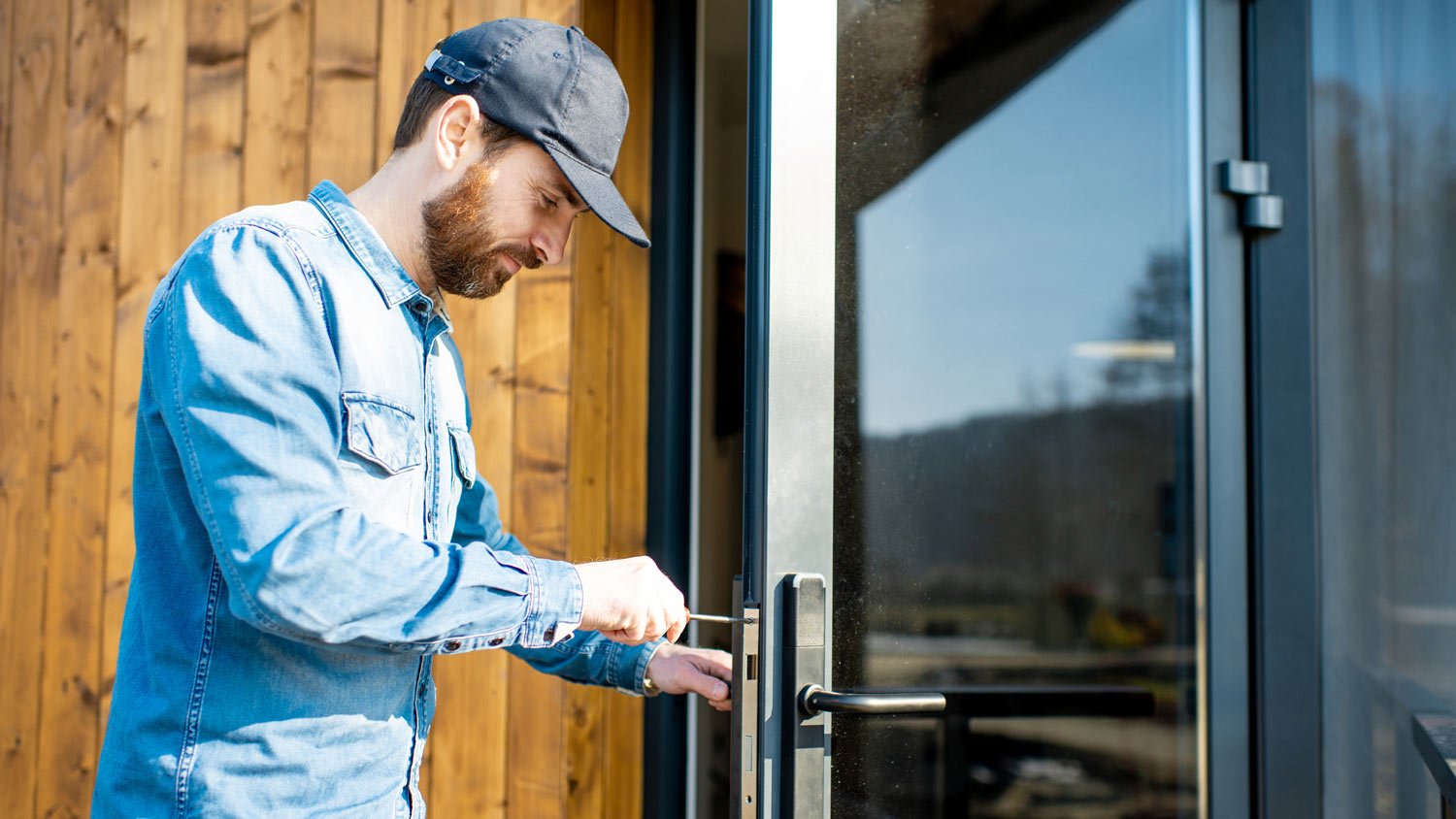
Wondering how much a locksmith costs? Discover locksmith prices, key cost factors, and tips to save on home lockout, rekeying, and installation services.
When you’re in a jam, getting back inside is much simpler than you might think


While you could try picking a lock yourself, you risk damaging the door or the lock mechanism.
The cost to hire a locksmith ranges from $65 to $180, and it spares you the headache and expense of later repairing a damaged lock or door.
Even locksmiths sometimes face stubborn locks; when you call in an expert with the right tools and experience, you’re more likely to get back into your home swiftly and securely.
At some point, you may find yourself locked out of your home and unable to get ahold of a professional locksmith for help. Using some simple tools and a lot of patience, you can learn how to pick a door lock without causing damage. As long as it's only done on your own property, lock picking is a useful skill that can help you better understand your home's security.
In popular culture, lock picking is a discreet practice commonly associated with spies and criminals. In reality, most states allow private citizens to own lock-picking tools for personal use, and many hobbyists learn to pick locks for fun.
However, using a lock pick set to enter someone else's home or gain access to their property is still illegal. Further, many states have laws that consider owning lock-picking tools as evidence of criminal intent. If you're caught with lock-picking tools in these states, you'll need to prove that you didn't plan to use them to commit a crime to avoid criminal charges.
Picking different types of locks can feel like a deja vu experience—the process can be repetitive —but many of them have their quirks. Generally, you’ll need a tension wrench and a pick—an extra safety pin works too. Before you start, make sure your lock isn’t broken and confirm which direction your key turns. If you find yourself locked out and need a way to get back in your home, here are five common door locks you may be able to pick.

A knob lock is one of the most common door locks. They’re everywhere, especially on exterior doors. With their straightforward design, featuring a simple knob and a keyhole right in the center, they make locking and unlocking a breeze. But what happens when you find yourself keyless? If you’re without your key, you can:
Insert the tension wrench. Place the tension wrench at the bottom of the keyhole, applying gentle pressure in the direction you’d turn the key.
Feel for the pins. Use your pick (or safety pin) to explore the lock and search for the pins inside.
Set the pins. Gently lift each pin until you hear a click—this means it’s set. Keep slight pressure on the wrench as you lift the pins.
Turn the knob. Once all the pins are set, turn the knob while maintaining tension.
Lever handle locks are popular choices for interior doors. They offer a user-friendly design that’s easy to operate. Instead of fumbling with a traditional knob, you simply push down on the lever, which often features a keyhole right in the center.
Lever handles are convenient, but you won’t typically find them on exterior doors as they’re not as sturdy as knob locks. Even so, the process is surprisingly similar to picking a knob lock. Insert the tension wrench at the bottom of the keyhole, use your pick to feel for the pins inside the lock, lift each pin, and turn the lever down while holding tension on all the pins.
Unlike standard locks, deadbolt locks don’t have a handle, which means you can’t simply push the door open once unlocked. Instead, when locked, a sturdy metal bar extends deep into the door frame, making it nearly impossible to force the door open—even if someone manages to unlock the knob. That’s why deadbolts are a go-to choice for exterior doors, giving homeowners an extra layer of security. If you ever find yourself locked out, picking a deadbolt isn’t much different from other locks.
Insert the tension wrench. Slide the tension wrench into the bottom of the keyhole, applying gentle tension in the direction the lock turns.
Feel for the pins. Poke your pick into the top of the lock and press until you find a pin.
Set the pins. Use the end of the pick to lift the pins. Push deeper to find the remaining pins.
Maintain tension. Keep the tension on the wrench.
Turn the wrench. Once all the pins are set, turn the wrench to unlock the deadbolt.
A cam lock is often found on cabinets, lockers, and furniture. These easy-to-use locks work with a small key that, when turned, rotates a metal arm (or cam). To unlock a cam lock, you can:
Gather your tools. Grab a small flathead screwdriver.
Insert the screwdriver. Slide the screwdriver into the keyhole and apply gentle pressure as if you’re turning the key.
Rotate the cam. Carefully turn the screwdriver to rotate the cam mechanism. Once the cam is fully rotated, the lock should open.
Padlocks aren’t typically used on exterior doors. Padlocks aren’t fixed to anything so you might see them on everything from garden sheds to bike chains. They secure by closing a loop around a solid object, creating a secure barrier. Padlocks come in all sizes and range from small and compact to large and hefty. To pick a padlock:
Insert the tension wrench. Place it at the bottom of the key and apply light pressure in the direction the lock turns.
Insert the pick. Slide it into the top of the key to feel for the pins.
Set the pins. Gently lift each pin until you hear a click.
Maintain tension. Keep applying pressure with the wrench as you continue setting the pins.
Rotate the cam mechanism. Once all the pins are set, turn the tension wrench to open the lock.

The lock-picking process may be simple, but it still requires a lot of time and patience to learn. Be patient as you get a feel for the amount of pressure you need to put on your tension wrench and the finesse of working your rake pick. This advice rings especially true for those using homemade tools.
Whether you're in a pinch and looking to pick a lock immediately or simply curious about learning a new skill, keep these tips in mind:
Consider carrying a basic lock pick set for emergencies. You can purchase a compact pick card that fits the required tools into your wallet.
You may find with some locks that putting constant pressure on the tension wrench isn't working. In these cases, try alternating between two slightly different pressure levels.
If the door doesn't unlock within ten seconds of scrubbing, release the tension wrench and remove the pick. Start over with less pressure on the wrench.
If you’re unsure about your tools or technique, call a locksmith near you to avoid the risk of damaging your lock.
While the thrill of picking a lock might make you feel like a secret agent, let’s face it—this isn’t a spy movie. The reality is that it carries some serious risks. Even with practice, you could accidentally damage your lock, turning a minor problem into a bigger one. If you have a spare lock lying around, that’s the perfect training ground. But remember, practice should happen long before you find yourself locked out.
Even seasoned professionals can struggle with stubborn locks, so if you’re feeling unsure, it’s always best to call in the professionals. They have the tools and expertise to get you back inside without causing damage or added stress. Practicing can be fun, but when it counts, relying on an expert is the smartest move. Your door—and your sanity—will thank you.
Beginner lock pick sets can be purchased online. These sets vary in quality but can start for as little as $20 for a kit with a tension wrench and several picks. However, if you damage your door while attempting to pick a lock, keep in mind that the average cost to change locks is $500, and the average cost to fix a door is $230.
For these reasons, it's always best to call a professional locksmith if you are locked out of your home or in an emergency. Pros will ensure the job is done properly and help you avoid accidental damage. The average cost to hire a locksmith to unlock your house is just $65 to $180, making it far more cost-effective than damage control.
Custom Paint Jobs LLC turned our outdated bathroom into a modern masterpiece.
Window Depot did an amazing job on my deck. I wasnt sure what I wanted to do, but their composite decking was affordable and will last a long time. I am excited to have family over, and I am no longer embarrassed by my backyard. Jeff and the ground crew were polite, respectful, and caring for...
We used Unique Hardwood Floor LLC three years ago to work on the floors of a 70 year old home that needed a great deal of work. Some floors needed repairs, some were replaced and others just needed to be refinished. It was a complicated job as they needed to blend the old and the new to...
Horrible. Did not reply to my numerous Emails and phone calls.
Excellent service. Prompt and professional. Will use again for any locksmith needs.
I contacted Greg through the Angie's List message center. He replied through the message center and called the next morning to schedule the service call. He arrived promptly. He rekeyed the front and back door locks. He was done in under a half hour. Even my dog liked him. I couldn't have...
Person assisting us was very helpful and offered many suggestions
From average costs to expert advice, get all the answers you need to get your job done.

Wondering how much a locksmith costs? Discover locksmith prices, key cost factors, and tips to save on home lockout, rekeying, and installation services.

Discover the average deadbolt installation cost, price factors, and tips to save on your project. Learn how to budget for secure home upgrades.

Uncover the cost of lock replacement. Discover labor, materials, and cost-saving tips for your next lock replacement project.

Need new locks or locked out? You probably have questions about finding a reliable locksmith. This guide can help you hire a professional you can trust.

Need to get a broken key out of a lock? There are a few ways you may be able to do it on your own with tools you already have lying around. Get the steps in this article.

Rekeying or replacing your locks are upgrades you can make to boost your home’s security. Learn about their differences to decide which solution is best for you.